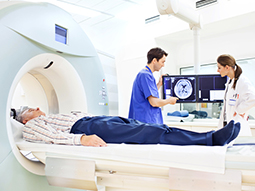A celiac plexus block is performed to reduce pain in the abdomen caused by cancer and chronic pancreatitis. Performed as both a diagnostic test and a treatment guided by advanced imaging, a celiac plexus block is an injection of local anesthesia in or around the nerves surrounding the aorta, which is the main artery in the abdomen.
Why they are performed
Pressure or injury to the celiac plexus nerves often results in excruciating abdominal pain and is caused by cancers or diseases of the:
- Gallbladder
- Intestines
- Liver
- Pancreas
In particular, pancreatic cancer patients can experience severe pain that can only be reduced by a celiac plexus block. When interventional radiologists perform celiac plexus blocks, it prevents the nerves from sending pain messages to the brain.
What to expect
Celiac plexus blocks are typically performed in an outpatient setting by an interventional radiologist. In most cases, the procedure can be completed in less than 30 minutes. Unlike traditional surgery, you will not undergo general anesthesia. Instead, you will receive sedation through an intravenous (IV) line, which will help you to stay comfortable and relaxed during the procedure.
Next, local anesthesia will be used to numb the area of your back where your interventional radiologist will make a pinhole-sized incision and insert a small needle. X-ray technology will guide the needle to the appropriate position along the spine. Occasionally two needles are used to ensure the entire area is treated. Once in place, your interventional radiologist may use a dose of dye to confirm where the injection will spread. The physician will then inject the medication through the needle.
After the celiac plexus block is complete, pressure will be applied to stop any mild bleeding but no stitches will be needed. You may feel a warm sensation in your abdomen from the medication. Additionally, you should notice significantly less abdominal pain.
Risk and benefits
The major benefit of a celiac plexus block is a significant reduction in abdominal pain. As a safe, minimally invasive procedure, celiac plexus blocks typically require only a small incision. As a result, patients experience fewer complications and a faster recovery than surgery.
As with any medical procedure, complications are possible. Although rare, risks may include:
- Bleeding
- Infection
- Nerve damage
- Paralysis
- Puncture of a nearby organ or blood vessel
However, the benefits far outweigh the risk. Our interventional radiologists are trained to minimize complications through the use of advanced imaging and equipment, which allows them to deliver treatment with precision and accuracy.
How to prepare
Prior to your procedure, your interventional radiologist will ask you about all current medications, as some may need to be stopped prior to the scheduled procedure, including blood thinners. Your care team will communicate any restrictions on eating and drinking prior to your appointment time. Because you will receive sedation during your celiac plexus block, be sure to arrange for a ride home.
If you think you might be pregnant, be sure to tell your healthcare provider, as special precautions may be necessary to protect both mother and baby during a celiac plexus block.
Post celiac plexus blocks
Because celiac plexus blocks are performed in an outpatient setting, you can expect to go home the same day of your procedure. Your care team will advise you on when you can resume normal activities, which for most patients is within a few days following the procedure. While you may notice immediate pain relief, many patients need repeated injections to completely eliminate pain.
Our providers

Expert radiology care
Getting the care you need starts with seeing one of our interventional radiologists.
Our locations
Distance from Change locationEnter your location
MedStar Good Samaritan Hospital
5601 Loch Raven Blvd. Baltimore, MD 21239
MedStar Franklin Square Medical Center
9000 Franklin Square Dr. Baltimore, MD 21237
MedStar Harbor Hospital
3001 S. Hanover St. Baltimore, MD 21225
MedStar Union Memorial Hospital
201 E. University Pkwy. Baltimore, MD 21218
MedStar Georgetown University Hospital
3800 Reservoir Rd. NW Washington, DC, 20007
MedStar Washington Hospital Center
110 Irving St. NW Washington, DC 20010
MedStar Southern Maryland Hospital Center
7503 Surratts Rd. Clinton, MD 20735
MedStar Montgomery Medical Center
18101 Prince Philip Dr. Olney, MD 20832
MedStar St. Mary’s Hospital
25500 Point Lookout Rd. Leonardtown, MD 20650









